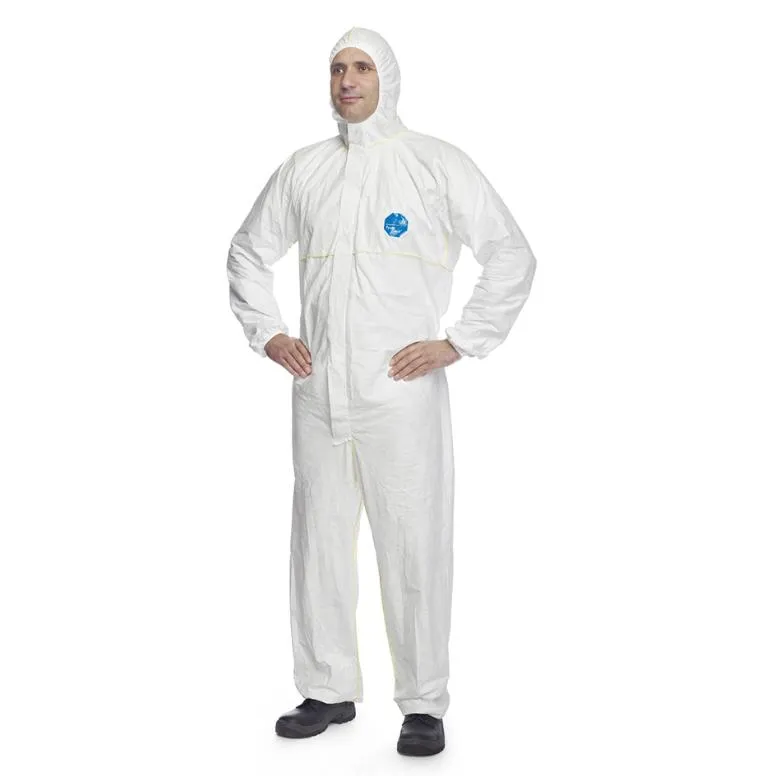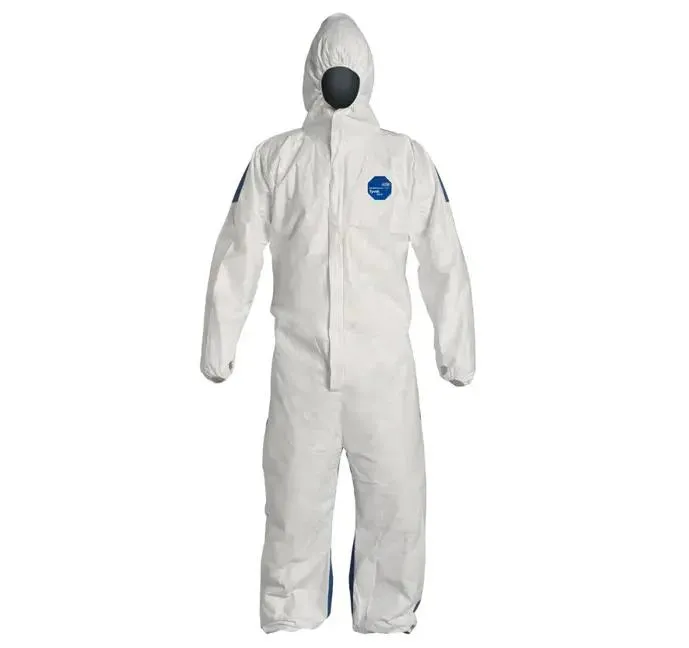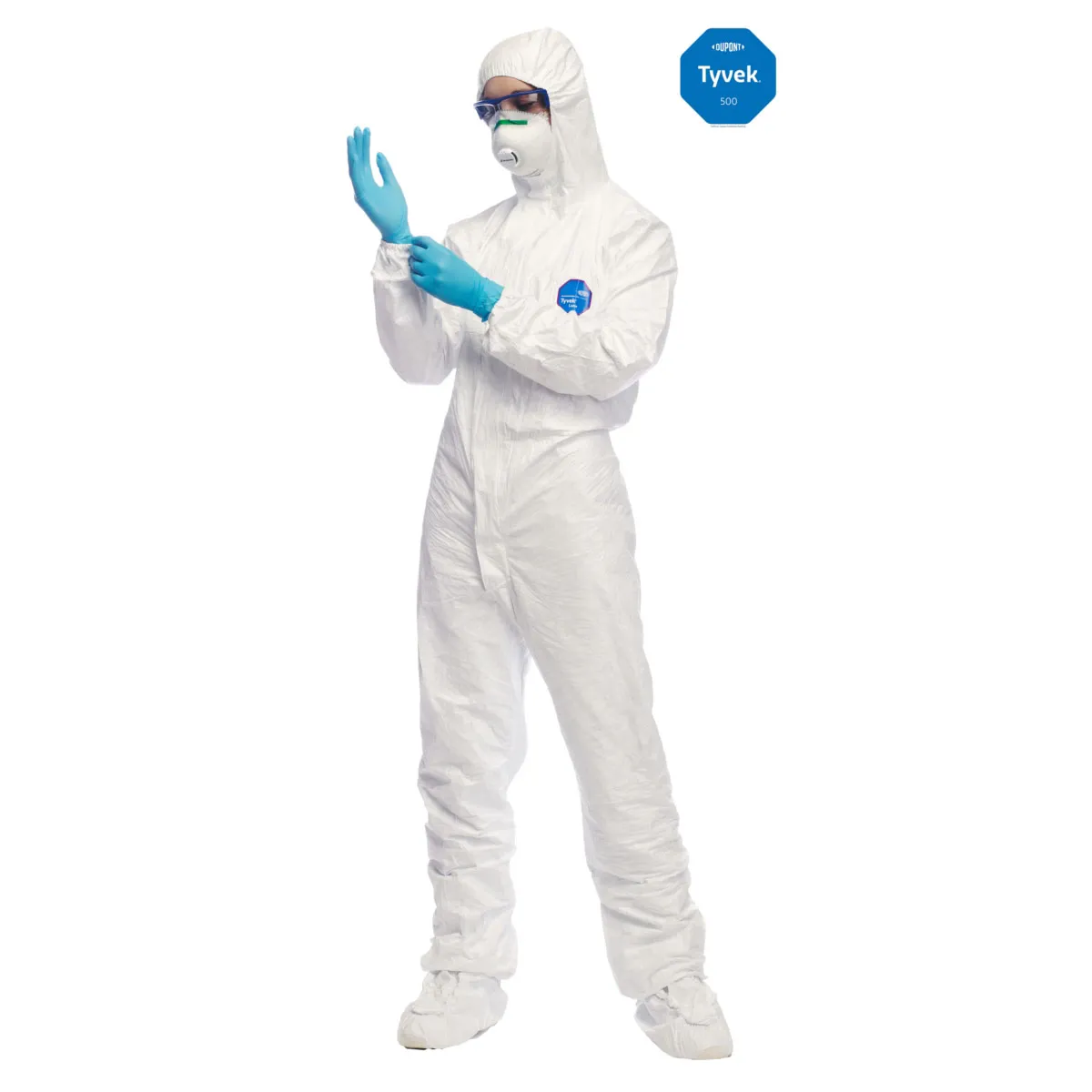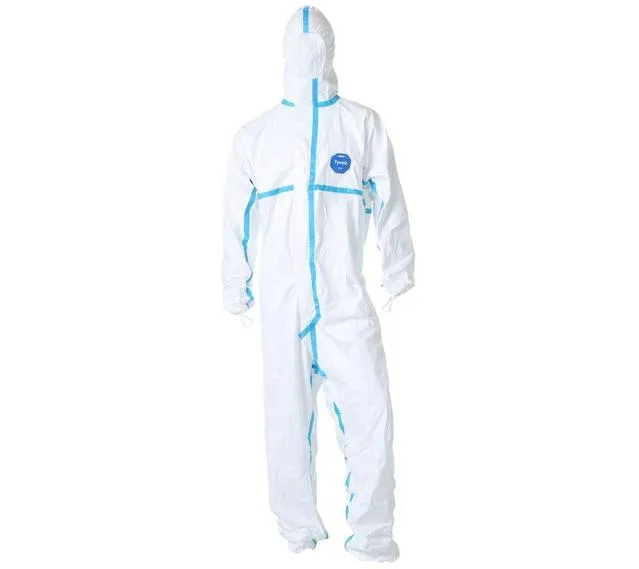You’ve probably seen different Tyvek coveralls but aren’t sure which one to pick. Some feel too thin, others too stiff, and the wrong choice can risk safety or slow work. That’s why we’ve created this guide. Here, we break down Tyvek Coverall comparison: 200, 400, 500 & 600, so you can quickly understand their features, uses, and benefits.
Tyvek 200 Coverall – Features & Applications
Material and Comfort
We make Tyvek 200 coveralls from flash-spun high-density polyethylene (HDPE). This gives them a soft and lightweight feel. The material has a more open design than the Tyvek 500 and 600. I find this makes them more breathable for long workdays, but it does mean they offer less barrier protection.
Protection Levels & Certifications
These Tyvek coveralls meet Category III, Type 5, and Type 6 protection standards (EN 13982-1 and EN 13034). This means they protect you from non-hazardous dry particles and light liquid splashes.
Tyvek coverall 200 provides a good barrier against light contact with radioactive particles (EN 1073-2 certified).
Both sides have antistatic properties that follow the EN 1149-5 standard.
Typical Applications
Based on my experience, Tyvek 200 coveralls are a good choice for:
– Light cleaning and general maintenance where there is no risk from hazardous materials.
– Cleaning dry dust in safe industrial settings.
– General manufacturing, and when you handle dry powders.
– Industrial clean-ups that need a basic barrier.
– I suggest them for short-term visitor protection in low-risk areas of a building.
Design Highlights
These Tyvek coveralls come in white with a hood. The face, wrists, waist, and ankles are elastic to create a snug seal.
You can easily spot them by the yellow stitching on the outside seams.
Each DuPont Tyvek coverall is packaged by itself. They come in sizes from SM to 3X and weigh less than 180g per garment.
It includes a front zipper flap for easy use.
Performance Data & Protection
Abrasion resistance: >10 cycles.
Flex cracking: >40,000 cycles.
Tensile strength: >30 N.
Puncture resistance: >5 N.
Water penetration resistance: >9 kPa.
Surface resistance (antistatic): <2.5 x 10⁹ Ohm.
Chemical Resistance
Repellency to Sodium Hydroxide (10%): >95%.
Repellency to Sulphuric Acid (30%): >90%.
Resistance to penetration: Sodium Hydroxide (10%) and Sulphuric Acid (30%): both <5%.
Limitations & Warnings
Not flame resistant:
Do not use near open flames, sparks, or hot sources.
Do not use these in hazardous or wet environments. I recommend Tyvek 400 when you need a higher level of protection.
Summary Recommendation
I recommend the Tyvek coverall 200 for low-risk jobs and tasks with non-hazardous materials. It is a solid entry-level Tyvek coverall. For most jobs needing tougher protection, I suggest you choose a higher series, like the Tyvek coverall 400.
Tyvek 400 Coverall – My Thoughts on Its Features & Protection
Strong Barrier and Fabric Details
Based on my experience, Tyvek 400 coveralls use a special material called flash-spun high-density polyethylene (HDPE). This creates a nonwoven barrier that is very tough. It doesn’t break down from rubbing or general wear. I find this fabric offers:
– A solid barrier that blocks dry particles of 1 micron or more. This protection holds up even after heavy use or surface scrapes.
– Protection from light splashes of non-hazardous chemicals and water. This makes them useful for many different jobs.
– Water resistance: The fabric withstands up to 45 inches of H₂O pressure, so liquid has a hard time getting through (AATCC 127).
– It does not peel apart in layers like some other coveralls can.
Here are the key properties I look at:
– Thickness: 5.9 mils (ASTM D1777)
– Basis weight: 1.2 oz/yd²
– Burst strength: 50 psi (ASTM D774)
– Surface resistivity: <2.5 × 10⁹ Ω (EN 1149-1 antistatic)
– Breaking strength: 18 lb/in (machine), 22 lb/in (cross direction) (ASTM D5034)
– Flammability: Class 1 apparel (per 16 CFR 1610)
Comfort, Design & Sizing of Tyvek 400 Coverall
I believe the comfort and design are major strengths of the Tyvek coverall 400:
– Design: I like the hooded styles because they offer a comfortable, well-shaped fit. The 3-piece hood covers your face well but still lets you move freely.
– Elastic details on the wrist, ankle, and a glued-in waist help keep contaminants out. The seams are stitched strongly, making them durable for multiple uses.
– Extra material in high-stress areas helps reduce the risk of tearing. I think this is important for active work.
– Longer zippers and a storm flap make it easy to put the coverall on and take it off. This also gives you extra splash protection.
– They are antistatic and create very little lint. This makes them a good choice for sensitive work areas.
– For hot jobs, I recommend the Tyvek coverall 400 Dual model. It combines a strong barrier in front with a breathable back panel. This improves comfort in warm environments.
– Sizes: You can find standard models from SM to 3XL. Some lines even go up to 7XL.
–Packaging:
They usually come 100 to a box. Each Tyvek disposable coverall is wrapped separately for better hygiene.
Industry Certifications & Durability of Tyvek 400 Coverall
Tyvek coverall 400 is certified to ASTM and EN standards. This proves its strength, how well it blocks particles, and its antistatic quality.
It also meets Class 1 flammability rules for workplace safety.
Durability:
I’ve found that Tyvek coverall 400 keeps you protected even after a lot of physical wear and movement. This makes it more dependable than other options that can fail after being scraped.
Common Applications & Use Cases of Tyvek 400 Coverall
From what I’ve seen, Tyvek coverall 400 is used in many industries:
– Manufacturing and industrial work
– Handling pharmaceuticals and clean-up jobs
– Agriculture, spray painting, and general repairs
– Pandemic or disaster response work
– Projects for removing asbestos and lead
– Food processing plants
Example Application:
A paint factory can give workers Tyvek 400 coveralls. The material blocks fine paint powders and solvent splashes. The fit is comfortable and breathable. This means staff can wear them for long shifts and not get too hot, even when working hard in warm areas.
Notable Tyvek 400 Models
TY198S WH:
This is the main coverall. It’s hooded, has stitched outer seams, and is lightweight (<180g). It comes in sizes SM–3XL.
TY222S WH:
A knee-length lab coat. It has snaps for closure, a mandarin collar, and three pockets.
TY658S WH:
A Tyvek coverall with a hood and elastic around the face and neck. The face opening is wide.
TY466S WH:
A boot cover. You can get it with a slip-resistant sole. It uses elastic and ties to stay on.
Tyvek 500 Coverall – Protection, Features & Real-World Uses
Enhanced Barrier & Protection Data of Tyvek 500 Coverall
Tyvek 500 coveralls use a special material from DuPont called flash-spun high-density polyethylene (HDPE). This creates a unique nonwoven fabric. From my experience, this material gives you a great mix of protection, toughness, and comfort.
Protective Performance Highlights:
– It blocks particles 1 micron or larger. I find it works well against both dry dust and some wet messes.
– It’s a Category III coverall. This means it is certified for EN Type 5-B (solid particles) and 6-B (light liquid splashes or sprays).
– It protects against infectious agents and meets the EN 14126 standard. This includes ISO 16603 Class 3 for body fluids and ISO 16604 for blood-borne pathogens.
– You can use it for protection from radioactive particles, as it meets EN 1073-2.
– It has an antistatic treatment on both sides (EN 1149-5).
Key Mechanical Properties:
– Thickness: 140 µm. I think this is quite strong and good for long work sessions.
– Burst Strength: 345 kPa.
– Tear Resistance: 27 N (machine direction), 20 N (cross direction).
– Tensile Strength: 82 N (lengthwise), 68 N (crosswise).
– Hydrostatic Head: 48 inches H₂O. This shows it has strong resistance to water getting through.
– Surface Resistivity: <2.5 × 10⁹ ohms for static control.
Ergonomics & Design Innovation of Tyvek 500 Coverall
I recommend these Tyvek coveralls for tough jobs because they are designed to be comfortable for long periods:
– The hood is shaped to fit your head well and gives good coverage.
– It has elastic around the face, wrists, and ankles. The waistband is glued in. This creates a tight, safe fit to help keep contaminants out.
– The outside seams are serged. In my experience, this makes them better at resisting liquid splashes.
– It features an auto-lock zipper with a storm flap. This makes it easy to put on and protects your chest.
– You can wear this over a fall-arrest harness. I find it gives you plenty of room to move, which is great for active jobs.
High-Visibility Option:
I suggest the Tyvek 500 HV model if you need to be seen. It’s made of bright orange fabric with silver reflective bands (EN ISO 20471 Class 3). This is perfect for worksites where visibility is key.
Practical Sizing, Color, and Packaging of Tyvek 500 Coverall
You can get it in white, blue, green, and high-visibility orange (HV model).
Sizes range from SM to 3XL for standard models.
They come in bulk boxes of 25 or 100. You can choose between single packs or eco-packs.
Each Tyvek coverall suit is very light, weighing less than 180g.
Example Applications & Use Cases of Tyvek 500 Coverall
Based on my experience, the Tyvek coverall 500 is a great choice for many tough jobs:
– I have seen them used in pharmaceutical labs. They protect workers from dangerous powders and other agents.
– They are useful in chemical plants. They block particles and light sprays of chemicals.
– You will find them in industrial cleanup, cleanrooms, and for hazardous maintenance work where you need this kind of protection.
– Other common uses include spray painting, areas with biohazard risks, and radioactive environments.
Notable Model:
I especially recommend the Tyvek 500 Xpert model. It offers the best barrier protection and comfort and works well with a harness. It is my top pick for tough industrial jobs or work that requires a lot of movement.
Model & Usage Overview of Tyvek 500 Coverall
Size range: SM, MD, LG, XL, 2X, 3X.
Colors: White, blue, green, hi-vis orange/silver (HV).
Packaging: You can buy them in bulk (25 or 100 per box). They come in either single packs or eco-packs.
Weight: <180 g per garment.
Real-world example: People use these all the time in pharmaceutical mixing rooms and chemical plants. I see them as a standard part of many industrial contractor PPE kits.
Tyvek 600 Coverall – Advanced Protection, Performance & Industry Use
Material & Protective Strength of Tyvek 600 Coverall
The Tyvek 600 coverall is made from a special high-density polyethylene (HDPE). Based on my experience, its barrier is much stronger than the Tyvek 200, 400, or 500 models. The fabric creates very little lint and contains no silicone. It also has an antistatic treatment on both sides. I believe this makes it safer when you work near sensitive electronics or in high-risk industrial areas.
Particle & Chemical Barrier of Tyvek 600 Coverall
The Tyvek 600 coverall provides a strong barrier against particles as small as 1 micron. I find this excellent for jobs that need tight contamination control. Its chemical protection is also impressive:
– Repellency to Sodium Hydroxide (10%) and Sulphuric Acid (30%) : Both repel over 95% of these liquids.
– Resistance to penetration: Less than 1% of either chemical gets through, even with pressure applied.
– We tested it with other low-concentration chemicals. These included acetic acid (30%) and ammonium hydroxide (16%, 28–30%).
Biological Barrier & Hazmat Use of Tyvek 600 Coverall
I recommend these Tyvek coveralls as they resist blood, body fluids, and other biological dangers:
– Withstand up to 3.5 kPa in synthetic blood resistance tests (ISO 16603).
– Block blood-borne pathogens under pressures up to 1.75 kPa (ISO 16604).
– They reduce airborne biological contaminants by a factor of 1 to 3 logs. This meets ISO and EN standards for protecting against infectious agents.
– The suit is certified to EN 14126 for use as a barrier against infectious agents. I feel this is essential for pandemic response and high-risk medical work.
Technical Performance Details of Tyvek 600 Coverall
Basis weight: 41.5 g/m²
Thickness: 140 µm
Tensile strength: 82 N (machine), 68 N (cross)
Tear resistance: 27 N (MD), 20 N (XD)
Burst strength:345 kPa
Flex cracking resistance : >100,000 cycles (ambient), >4,000 cycles at –30°C
Puncture resistance : >10 N
Hydrostatic head: 48 inches H₂O
Water penetration resistance : >10 kPa
Surface resistivity : <2.5 × 10⁹ Ω at 23°C/25% RH
Temperature range : It stays flexible down to –73°C and melts at 135°C.
Ergonomic Design & Comfort Features of Tyvek 600 Coverall
Hooded design: This covers your full head, neck, and face.
Stitched and taped seams: The seams are both stitched and taped. This greatly lowers the risk of liquids or particles getting inside. I suggest it for hazardous work.
Thumb loops: These loops hold your sleeves in place under gloves to keep your skin from being exposed.
Tunneled elastication: Elastic bands are inside the cuffs, ankles, and face opening. This provides a snug fit and makes long shifts more comfortable.
Glued waist and self-adhesive zipper flap with chin guard: These features create a tight, comfortable seal to keep you safe from contaminants.
Models, Sizes & Packing of Tyvek 600 Coverall
Notable model: I recommend the Tyvek 600 Plus CHA5. It is a great choice for pharmaceutical and cleanroom jobs.
Available sizes: S–3XL
Packaging: Each Tyvek protective coverall suit is folded and packed by itself to help control contamination.
Industry Applications & Typical Use Cases of Tyvek 600 Coverall
Pharmaceutical manufacturing, handling, and quality control
Chemical and biological research labs
I suggest it for spray painting and industrial cleaning tasks that need top-level contamination control.
It is also useful for advanced cleaning, maintenance, and handling dangerous materials.
Many pharmaceutical plants use it to stop cross-contamination in their production lines.
Used in pandemic and biosafety responses
Example & Certifications
In my experience, it is a go-to choice for front-line PPE during disease outbreaks because it meets the EN 14126 standard.
Pharmaceutical sites choose it to protect both their people and their processes.
Quick Comparison Table
| Tyvek Coverall Model | Main Feature | Protection Level | Standards | Common Uses |
|---|---|---|---|---|
| Tyvek 200 |
Lightweight, breathable | Dust only | – | Cleaning, dry environments |
| Tyvek 400 |
Standard protection | Dust + light liquid | Type 5, 6 | Asbestos, painting, and lab work |
| Tyvek 500 |
Enhanced splash resistance | Dust + liquid spray | Type 5, 6 | Food processing, spraying, pharma |
| Tyvek 600 |
Highest protection with sealed seams | Dust + liquid + biohazard | Type 4, 5, 6 | Chemical handling, healthcare, biohazards |
Summary:
To sum it up, here is my recommendation. I suggest Tyvek 400 for good breathability and general protection from particles or light splashes. I recommend Tyvek 500 for cleanrooms and protection from chemical mists. For the highest risks, like harsh chemicals or infectious materials, I believe Tyvek 600 is the best choice because of its superior seams and barrier. My final advice is to always match the Tyvek coverall to your specific job’s risks and safety rules. If you need custom disposable coveralls, Morntrip can provide tailored solutions and quotes to meet your exact industrial or medical requirements.
FAQs of Tyvek Coveralls
Tyvek 500 Xpert vs. Standard Tyvek 500: What’s the Difference?
- Tyvek 500 Xpert: I like this model for its protective, form-fitting design. It has stitched external seams and elastic at the wrists, ankles, face, and waist. It also includes a full Tyvek zipper and storm flap. It is certified to top standards: CAT III, TYPE 5B, 6B, EN 1073-2, EN 14126, EN 1149-5 (antistatic on both sides).
- Standard Tyvek 500: This version still offers good protection. It just lacks the enhanced fit and upgraded seams of the Xpert model.
For tough jobs, Tyvek 500 Xpert is what I recommend. I believe its extra comfort and stronger protective features are worth it.
Are All Tyvek Coveralls Antistatic?
Many Tyvek coverall models, like the Tyvek 500 Xpert, have an antistatic treatment and meet the EN 1149-5 standard. This is very important when you work around flammable dust or in electronics. Here is my advice: Always check the certification for the exact model you are using. Not every version is antistatic.
Can Tyvek Coveralls Be Reused?
In my professional opinion, Tyvek coveralls are for single use only. They are disposable protective garments. After exposure to a hazardous substance, I believe the protective barrier is no longer effective. I strongly advise against reusing them, especially in chemical, biological, or contaminated areas. You should always follow your workplace’s safety and disposal rules.
Are Tyvek Coveralls Latex-Free?
Yes, Tyvek coveralls are latex-free and do not contain silicone. This makes them a great choice for people with latex allergies. It also makes them safe for clean environments where you must avoid any kind of contamination.




